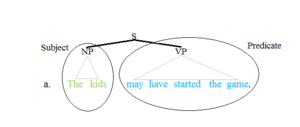Predicate (grammar) facts for kids
The predicate is a super important part of a sentence or clause. Think of it as the second main part, right after the subject. The subject is usually who or what the sentence is about. The predicate then tells you more about that subject – like what it's doing, what it's like, or what's happening to it.
Imagine a sentence like "The dog barks loudly."
- "The dog" is the subject.
- "barks loudly" is the predicate. It tells you what the dog is doing!
The predicate always includes a verb, which is an action word or a "being" word (like "is," "are," "was"). It can also include other words that help complete the idea.
Here are some examples of predicates:
- She dances. - Here, the predicate is just the verb.
- Ben reads the book. - The predicate includes the verb "reads" and what Ben reads ("the book").
- Ben's mother, Felicity, gave me a present. - This predicate tells you what Felicity did ("gave") and to whom ("me") and what she gave ("a present").
- She listened to the radio. - The predicate tells you what she listened to.
- They elected him president. - This predicate shows what they did ("elected") and who they elected ("him") and what he became ("president").
- She met him in the park. - The predicate tells you who she met ("him") and where ("in the park").
- She is in the park. - Here, the predicate uses the verb "is" to tell you where she is.
The predicate gives us all the key information about the subject. It's like the "action" or "description" part of the sentence.
Different Ways to See Sentences
While the idea of a subject and a predicate is a classic way to understand sentences, there are other ways too! Some language experts look at sentences differently. For example, some theories focus on the finite verb (the main action word) as the most important part, with everything else connecting to it. But for understanding how sentences work, knowing about subjects and predicates is a great start!
See also
In Spanish: Predicado (gramática) para niños



